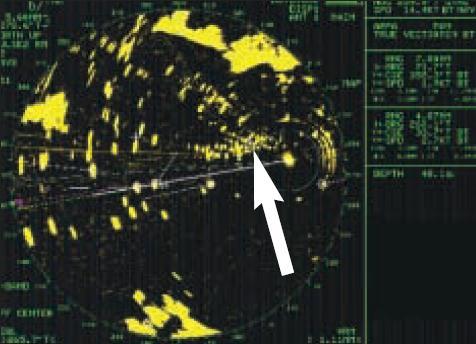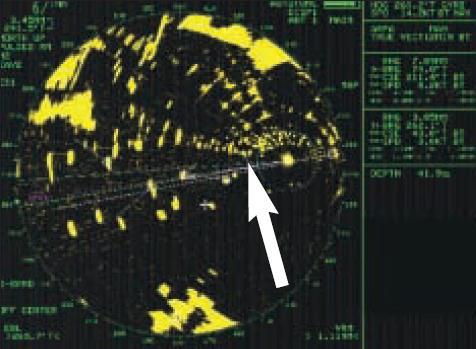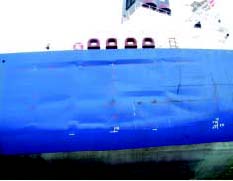200738 Collision in TSS
A laden product tanker was westbound in a very congested TSS in the early hours of the morning (night navigation conditions). At the appropriate stages in the passage plan, notice was given to engine room, the master took over the con and the ship continued navigating in the TSS. Positions were plotted at frequent intervals as specified in the passage plan. The bridge team included the OOW, an AB and a deck cadet.
At about 05.10, the OOW went inside the chart room to plot the vessel's position. Thereafter, he returned to the wheelhouse while the master went inside the chart room to check the vessel's position. At this time, the OOW sighted an unidentified vessel emerge from a cluster of anchored ships and crossing ahead from starboard to port at a very close range.
The master was immediately alerted and due to lack of sea room on the starboard side, he ordered wheel hard over to port. The OOW noted the crossing vessel's name on the AIS and attempted to alert the crossing vessel on the VHF about the impending danger, without success.
Meanwhile, with the port helm order, the tanker had turned almost 90deg from her original heading, but could not avoid a glancing contact on her starboard quarter with the crossing vessel. The tanker immediately reported the collision to the VTS, but no response was received from the crossing ship, which continued on her course. The port authorities instructed both the vessels to proceed to the pilot station, where they were inspected externally. After confirming that both were structurally safe and there was no pollution risk, they were given pilots and escorted to a safe anchorage. Fortunately, neither vessel's hull was breached, and there was no injury or pollution. Both vessels underwent repairs in port and proceeded on their respective voyages.
 Radar Picture 1 – Crossing vessel (shown by white arrow) still obscured by intervening echoes.
Radar Picture 1 – Crossing vessel (shown by white arrow) still obscured by intervening echoes.
 Radar picture 2: Crossing vessel suddenly emerging from cluster of anchored ships echoes about 1.5 miles on starboard bow and crossing on collision course (shown by white arrow).
Radar picture 2: Crossing vessel suddenly emerging from cluster of anchored ships echoes about 1.5 miles on starboard bow and crossing on collision course (shown by white arrow).
Root cause/contributory factors
The bridge team on the product tanker was blinded by the bright deck lights of the large number of anchored vessels from where the crossing vessel suddenly emerged about four to five minutes before collision, and was first seen by the lookout and OOW only when she was less than 0.5 nautical mile away.
The crossing vessel's forward working and deck lights were still lit, such that her port sidelight was not easily seen and the tanker's bridge team was misled to assuming that the crossing vessel was at anchor.
The tanker's engine was ready for manoeuvring but the speed was too high to take effective action to avoid collision.
Inadequate risk assessment: even though a precautionary area was marked on the chart and main engine was in a state of readiness for manoeuvring, lack of reaction time and sea room were not considered.
Ineffective lookout and failure to take independent action to avoid collision on the part of the crossing vessel.
Lack of communication: the crossing vessel failed to inform VTS and other traffic about her intention to leave the anchorage and cross the traffic lane.
The tanker's operator conducted an in-house investigation and it was established that all SMS procedures had been properly followed. However, the following observations were made:
The radar was stabilised with GPS instead of speed over water from the log
No warning was written in the passage plan to inform the bridge team about the expected crossing traffic in the area, even though this information was included in the sailing direction abstract which was attached to the passage plan and also marked on nautical chart with a caution symbol.
Corrective actions on the tanker
A safety meeting was held on board in the presence of company management personnel soon after the incident, to discuss the outcome of investigations and to share the lessons learned with all crew members.
A report was circulated throughout the fleet instructing masters to maintain safe speed at all times and to promulgate the lessons learned from the incident.
Incident analysis report to be forwarded onboard all managed vessels and discussed among senior officers attending company seminars and pre-joining briefings.
An external auditor to be appointed by the company to perform a navigation audit on all company fleet.
Company procedures to be amended to emphasise the importance of maintaining an efficient lookout and safe speed while transiting precautionary areas.
Company procedures to be amended instructing masters to keep safe distance from anchorages.
All managed vessels to be supplied with a risk assessment training video.
Risk assessment in respect of navigation in coastal congested waters to be reviewed and precautions / safeguards amended.
Lessons learnt
In coastal waters or in traffic separation schemes, the restricted nature of the available sea room, and the high density of traffic, necessarily reduces the margins of safety. In these situations, it becomes particularly important to consider all the options available. If in doubt, err on the side of safety, and slow down.
Ships have to keep the maximum distance possible from crowded anchorages. This will allow the bridge team sufficient response time in case any vessel leaves anchorage suddenly.
 Damaged shell plating of the product tanker after collision
Damaged shell plating of the product tanker after collision
Editor's note: As is common in very busy ports, most coasters, fishing and small craft do not report to VTS or port authorities, therefore, their movements cannot be regulated. In this case, the crossing vessel, though a medium-sized cargo vessel, apparently failed to make reports to the VTS and hence was not being monitored.
